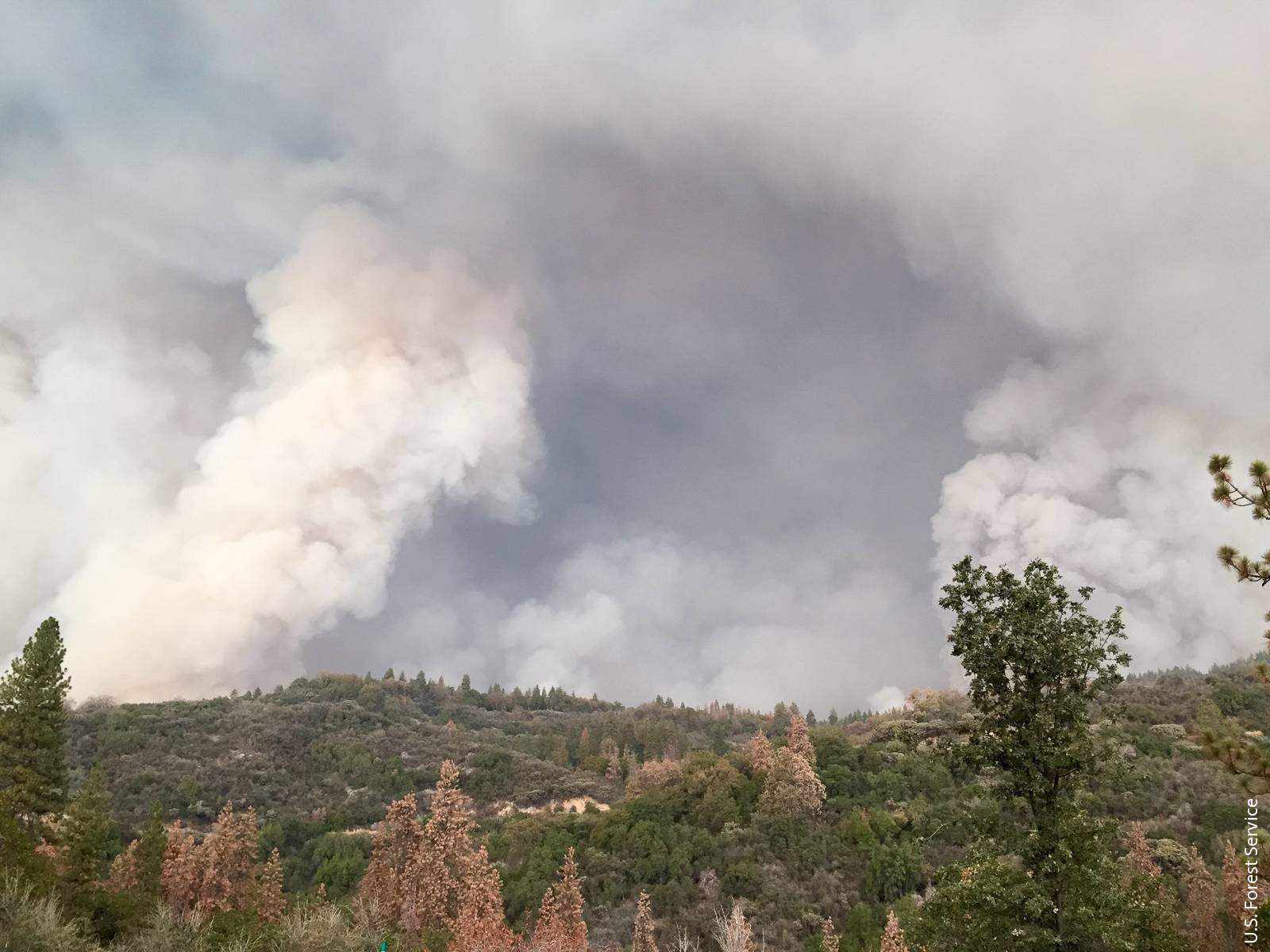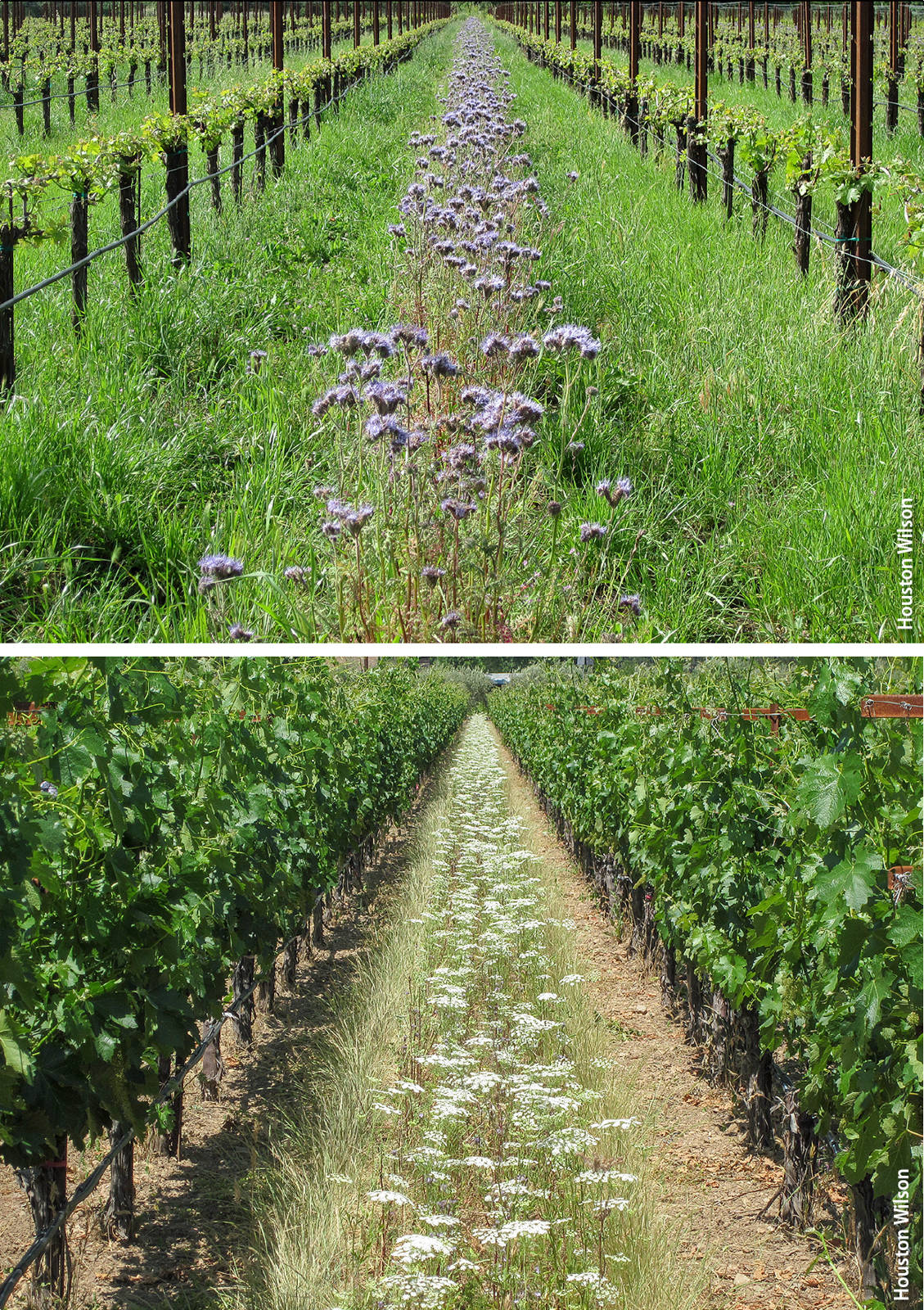All Issues
Research highlights
Publication Information
California Agriculture 72(2):105-106. https://doi.org/10.3733/ca.2018a0020
Published online June 26, 2018
PDF | Citation | Permissions
NALT Keywords
Summary
Briefs of recent AES and UCCE research papers on tree mortality, sugary drinks, mountain runoff and wild bees.
Full text
Tree mortality reduces the impact of a long drought on mountain runoff
Predicting the impacts of a lasting drought and a warming climate on mountain water runoff is complex, and critical for California's water security. A recent study identified four biogeophysical mechanisms that controlled the impact of the 2012–2015 drought on mountain runoff across the Kings River basin. One of them — mountain vegetation changes, from tree dieback and wildfires — is often overlooked in water runoff projections. That may result in the impact of drought being overestimated.
A team of scientists led by UC Merced Professor of Engineering Roger Bales, and including scientists at UC Irvine and UC Davis, analyzed data from their measurements at different elevations in the Kings River basin before, during and after the 2012–2015 drought. During those drought years, mean precipitation in the southern Sierra Nevada was about 50% of average, and temperatures were higher than in past dry periods.
They identified four mechanisms affecting runoff. Evapotranspiration assumed a greater fraction of precipitation as the drought continued, which they calculated would result in a decrease in the runoff across the basin by 30% compared to the long-term average runoff. The temperature increase of 1°C during the drought years compared to the previous 10 years was calculated to have decreased runoff by at least another 5%. The high elevation of the water source regions became more important as the drought progressed; because of those high slopes where precipitation consistently exceeded evapotranspiration, runoff was on average 10% higher than it would have been for a spatially more homogenous basin.
These three mechanisms are captured by state-of-the-art hydrologic models, but the fourth mechanism is not. In 2015 widespread conifer death occurred, and also a wildfire affected nearly 20% of the basin; the subsequent decline in evapotranspiration could increase the basin-wide runoff by 15% of the long-term average. If this mechanism of drought-affected vegetation loss is not accounted for, the researchers conclude that predictions of mountain water runoff may be too low.
Bales RC, Goulden ML, Hunsaker CT, et al. Mechanisms controlling the impact of multi-year drought on mountain hydrology. Scientific Rep. 2018. 8(1):690- https://doi.org/10.1038/s41598-017-19007-0 PubMed PMID: 29330378
Unprecedented tree mortality increased risk of mass fires
More than 100 million trees have died recently in California, primarily in the southern and central Sierra Nevada, prompting the governor to declare a state of emergency in 2015. The main causes were acute drought and bark beetle damage. By suppressing fires in forests that historically depended on frequent fires for their survival, forest managers created very dense tree stands that are prone to both.
Of concern now, after this unprecedented death of standing trees, is the massive amount of dry, combustible material over extensive areas, and the potential for large severe fires, or “mass fires.” Scott Stephens, professor of fire science at UC Berkeley, led a team of UC and USDA scientists in collecting and analyzing field data from 50 mixed-conifer plots affected by tree mortality that subsequently burned in the 2015 Rough Fire wildfire. Results showed that fire spread increased as prefire tree mortality increased, but only up to prefire mortality levels of about 30% of plot trees. Further increases in prefire mortality did not result in greater fire severity.
The death of more than 100 million trees from drought and bark beetle damage in the Sierra Nevada has led to concerns about the large amount of combustible material and the potential for mass fires. A team of UC and USDA scientists studied 50 mixed-conifer plots affected by tree mortality that burned in the 2015 Rough Fire, a wildfire in the Sierra National Forest that consumed an estimated 139,133 acres. The results suggest that fire spread increased as prefire tree mortality increased, but only up to prefire mortality levels of 30% of plot trees.
The researchers conclude that in the first decade after a forest suffers significant mortality from bark beetles, wildfire severity may be little affected. However, in future decades, with more large-sized, long-burning dead material on the forest floors, mass fires could occur. A mass fire creates dangerously strong winds, resulting in fast-spreading fire and complicated fire patterns.
The implications for public safety and the future composition of forests, and the ecological services they provide, are serious. Public policy needs to shift, say the authors, because many management tools and tactics could be adopted, including prescribed fire, to help reduce future tree mortality and increase forest resilience.
Stephens SL, Collins BM, Fettig CJ, et al. Drought, tree mortality, and wildfire in forests adapted to frequent fire. Bioscience. 2018. 68(2):77-88. https://doi.org/10.1093/biosci/bix146
Flowering cover crops support wild bees and a regional sustainability agenda
Wild bees pollinate flowering plants in natural habitats and can play an important role in the pollination of several key agricultural crops, such as almonds, stone fruits and melons. Populations of wild bees are in decline, mostly due to habitat loss, which is largely driven by agricultural expansion. Grape growers in Napa and Sonoma counties sought to add habitat for beneficial insects, including wild bees, by planting flowering cover crops in row middles. Wild bee numbers increased on the cover crops, and although pollinators are not necessary for grape production, growers see the potential for such practices to bring added value to their wines as a result of increased consumer perceptions of vineyard sustainability.
A study of wild bee populations at vineyards found that bee abundance and diversity increased after flowering cover crops were planted. Phacelia tanacetifolia (top), Ammi majus (bottom).
Houston Wilson, assistant Cooperative Extension specialist with the Department of Entomology at UC Riverside, is the lead author of a 2-year study in the North Coast wine grape region evaluating bee response to summer-flowering cover crops. In fall 2011–2012, at 10 vineyard sites, rows were tilled and seeds of purple tansy, bishop's flower and wild carrot were sown in alternate row middles. These flower species bloom sequentially from April to September and don't require any supplemental irrigation. Control plots were tilled to leave alternate rows of weedy vegetation.
Total abundance and diversity of wild bees increased on all three flowering cover crop species relative to the resident weedy vegetation, where bee numbers were uniformly low. Researchers also studied the effect on wild bees of changes in landscape diversity — that is, the proportion of natural habitat, consisting primarily of riparian, oak woodland and chaparral habitats, within 0.5 kilometer of the study sites. Landscape diversity had no effects on numbers or species diversity of wild bees.
Wine grape growers' interest in conserving bees is part of a regional sustainability and conservation agenda. Farming practices that support biodiversity conservation attract consumers' attention and may lead indirectly to added crop value. Plus, the flowers add a stunning visual element to the vineyard, which consumers may appreciate as they taste wines on site.
Wilson H, Wong JS, Thorp RW, et al. Summer flowering cover crops support wild bees in vineyards. Environ Entomol. 2018. 47(1):63-9. https://doi.org/10.1093/ee/nvx197 PubMed PMID: 29300949
Children's high calorie, poor diets: sugar-sweetened beverages may be ground zero
Sugar-sweetened beverages (SSBs) are the main source of added sugar in children's diets. Evidence already exists that these beverages — soft drinks, fruit drinks with added sugar, sweetened coffee and tea drinks, sports and energy drinks, and sweetened bottled water — are associated with higher risks of obesity, metabolic syndrome, type 2 diabetes and heart disease. But how much does beverage choice explain children's dietary quality and calorie consumption that may lead to higher or lower risk for obesity and chronic disease?
A team of researchers from UC ANR, UC Berkeley and the University of Michigan investigated this question. They analyzed plain water and SSB consumption data from a nationally representative sample of 7,757 children from ages 2 to 18 years, drawn from the National Health and Nutrition Examination Survey. They were looking for the relationship between beverage intakes and children's diet quality and calorie intake. They used 24-hour dietary recalls to measure dietary intake and the Healthy Eating Index (HEI) 2010 to measure overall diet quality.
High SSB intake — more than two cups a day — was significantly associated with lower diet quality in every age group (2 to 5 years, 6 to 11 years, and 12 to 18 years). High water intake —also more than two cups a day — was significantly associated with higher diet quality in every age group. But, SSBs alone didn't account for the poor diet quality in the high SSB group. Compared with non-SSB drinkers, children with high SSB intake also had lower intakes of greens and beans, fruit, and other nutritious food groups, suggesting that children drinking high amounts of SSB were lacking proper nutrition.
Not surprisingly, children with high SSB intake consumed more calories. In fact, children with high SSB intake consumed an average of almost 400 calories more per day than their non-SSB drinking peers. Most of these excess calories were explained by calories from the SSBs, except among children aged 6 to 11 years old, for whom other foods also contributed to excess calories. Water consumption was not associated with calorie intake — high and low water drinkers did not consume a significantly different average caloric level.
Thus, the most effective public health efforts will explicitly discourage SSB consumption while encouraging water. Further, while swapping water for SSBs may contribute substantially to reducing obesity, additional efforts to improve diet also are needed, since high SSB consumers also consumed fewer fruits, vegetables, whole grains, and dairy.
Leung CW, Di Matteo SG, Gosliner WA, Ritchie LD. Sugar-sweetened beverage and water intake in relation to diet quality in U.S. children. Am J Prev Med. 2018. 54(3):394-402. https://doi.org/10.1016/j.amepre.2017.11.005 PubMed PMID: 29338950






